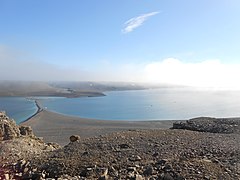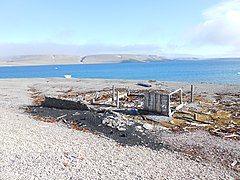
Sir John Franklin was a British Royal Navy officer and Arctic explorer. After serving in wars against Napoleonic France and the United States, he led two expeditions into the Canadian Arctic and through the islands of the Arctic Archipelago, in 1819 and 1825, and served as Lieutenant-Governor of Van Diemen's Land from 1839 to 1843. During his third and final expedition, an attempt to traverse the Northwest Passage in 1845, Franklin's ships became icebound off King William Island in what is now Nunavut, where he died in June 1847. The icebound ships were abandoned ten months later and the entire crew died from causes such as starvation, hypothermia, and scurvy.

Bathurst Island is one of the Queen Elizabeth Islands in Nunavut, Canada. It is a member of the Arctic Archipelago. The area of the island is estimated at 16,042 km2 (6,194 sq mi), 115 to 117 mi long and from 63 mi (101 km) to 72 mi (116 km) to 92.9 mi (149.5 km) wide, making it Canada's 13th largest island. It is located between Devon Island and Cornwallis Island in the east, and Melville Island in the west. Four small islands of Cameron, Vanier, Massey and Alexander lie in its northwest.

HMS Terror was a specialised warship and a newly developed bomb vessel constructed for the Royal Navy in 1813. She participated in several battles of the War of 1812, including the Battle of Baltimore with the bombardment of Fort McHenry. She was converted into a polar exploration ship two decades later, and participated in George Back's Arctic expedition of 1836–1837, the successful Ross expedition to the Antarctic of 1839 to 1843, and Sir John Franklin's ill-fated attempt to force the Northwest Passage in 1845, during which she was lost with all hands along with HMS Erebus.

Francis Rawdon Moira Crozier was an Irish officer of the Royal Navy and polar explorer who participated in six expeditions to the Arctic and Antarctic. In 1843, he became a Fellow of the Royal Society for his scientific work during his multiple expeditions. Later, he was second-in-command to Sir John Franklin and captain of HMS Terror during the Franklin expedition to discover the Northwest Passage, which ended with the loss of all 129 crewmen in mysterious circumstances.
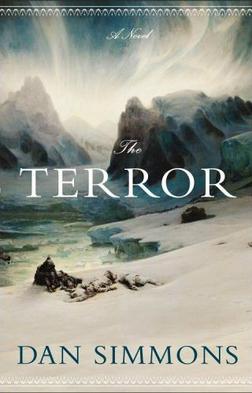
The Terror is a 2007 novel by American author Dan Simmons. It is a fictionalized account of Captain Sir John Franklin's lost expedition, on HMS Erebus and HMS Terror, to the Arctic, in 1845–1848, to locate the Northwest Passage. In the novel, while Franklin and his crew are plagued by starvation and illness, and forced to contend with mutiny and cannibalism, they are stalked across the bleak Arctic landscape by a monster.
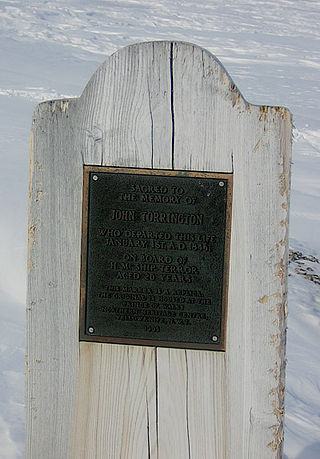
John Shaw Torrington was a Royal Navy stoker. He was part of the 1845 Franklin Expedition to chart unexplored areas of what is now Nunavut, Canada, find the Northwest Passage, and make scientific observations. He was the first fatality of the expedition, of which all personnel ultimately died, mostly in and around King William Island. Torrington was buried on Beechey Island. His body was exhumed by forensic anthropologist Owen Beattie in 1984, to try to determine the cause of death. His remains are among the best preserved example of a corpse since the ancient Tollund Man which was found in the 1950s. Photographs of his mummified remains were widely published and inspired music and literature.

Franklin's lost expedition was a failed British voyage of Arctic exploration led by Captain Sir John Franklin that departed England in 1845 aboard two ships, HMS Erebus and HMS Terror, and was assigned to traverse the last unnavigated sections of the Northwest Passage in the Canadian Arctic and to record magnetic data to help determine whether a better understanding could aid navigation. The expedition met with disaster after both ships and their crews, a total of 129 officers and men, became icebound in Victoria Strait near King William Island in what is today the Canadian territory of Nunavut. After being icebound for more than a year Erebus and Terror were abandoned in April 1848, by which point two dozen men, including Franklin, had died. The survivors, now led by Franklin's second-in-command, Francis Crozier, and Erebus's captain, James Fitzjames, set out for the Canadian mainland and disappeared, presumably having perished.
O'Reilly Island is an uninhabited island in Nunavut Territory, Canada. It lies to the south of King William Island and to the west of the Klutschak and Adelaide Peninsulas, in the easternmost part of the Queen Maud Gulf.
William Braine was a British explorer. He served as a marine in the Royal Marines. From 1845 he was part of an expedition to find the Northwest Passage, but he died early in the trip and was buried on Beechey Island. His preserved body was exhumed in 1984, to try to determine the cause of death.
John Hartnell was an English seaman who took part in Sir John Franklin's Northwest Passage expedition and was one of its first casualties, dying of suspected zinc deficiency and malnourishment during the expedition's first year.
Owen Beattie is a Canadian professor of anthropology at the University of Alberta.
Arctic Research Foundation (ARF) is a private, non-profit organization based in Canada. Federally incorporated in 2011, ARF works with Indigenous and Northern communities, NGOs, government, private corporations and academia to facilitate science research and community initiatives.

Frozen in Time: The Fate of the Franklin Expedition is a book by Owen Beattie and John Geiger, first published in 1987 by Bloomsbury Publishing. The book focuses on the dramatic events surrounding the Franklin Expedition of 1845-1848, led by Sir John Franklin, as well as the scientific work and forensic testing on the bodies of three perfectly preserved Victorian seamen 138 years after their deaths, solving the mysteries of the Franklin Expedition. In 2004, the authors substantially revised the book, adding an epilogue and altering and updating the text. Margaret Atwood wrote an introduction. In 2017, the authors added a new afterword to the Canadian edition, and a new foreword by Wade Davis was added.
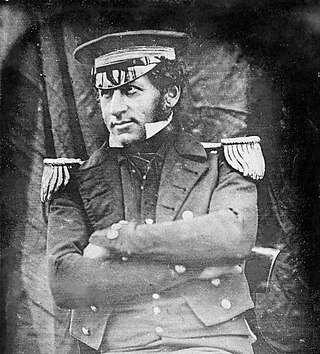
Graham Gore was an English officer of the Royal Navy and polar explorer who participated in two expeditions to the Arctic and a survey of the coastline of Australia aboard HMS Beagle. In 1845 he served under Sir John Franklin as First Lieutenant on the Erebus during the Franklin expedition to discover the Northwest Passage, which ended with the loss of all 129 officers and crewmen in mysterious circumstances.

The Wrecks of HMS Erebus and HMS Terror National Historic Site is a National Historic Site of Canada near King William Island in the northern Nunavut territory. It protects the wrecks of HMS Erebus and HMS Terror, the two ships of the last expedition of Sir John Franklin, lost in the 1840s during their search for the Northwest Passage and then re-discovered in 2014 and 2016. The site is jointly managed by Parks Canada and the local Inuit. Public access to the site is not permitted.

Nattilik Heritage Centre is a museum in Gjoa Haven, King William Island, Nunavut, Canada. It presents the history and culture of the local Inuit.
Wilmot and Crampton Bay is an Arctic waterway in the Kitikmeot Region, Nunavut, Canada. It is located on the eastern edge of Queen Maud Gulf, running along the western coast of the Adelaide Peninsula, south of King William Island.

Henry Thomas Dundas Le Vesconte was an English officer of the Royal Navy and polar explorer who from 1845 served under Sir John Franklin as Second Lieutenant on the Erebus during the Franklin expedition to discover the Northwest Passage, which ended with the loss of all 129 crewmen in mysterious circumstances.
Robert Anstruther Goodsir was a Scottish medical doctor, explorer and writer. He made two voyages to the Arctic in search of his brother Harry Goodsir who was lost with the Franklin expedition.
John Gregory was an English railway and naval engineer. He served as engineer aboard HMS Erebus during the 1845 Franklin Expedition, which sought to explore uncharted parts of what is now Nunavut, including the Northwest Passage, and make scientific observations. The ships were outfitted with former railway locomotive engines which served as auxiliary power units, which is why Gregory, who had never been to sea, served on the expedition. All expedition personnel perished in uncertain conditions, mostly on and around King William Island. In 2021, Gregory's remains became the first of the expedition to be identified using DNA analysis.



